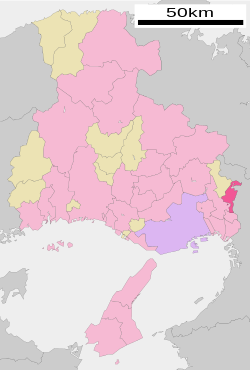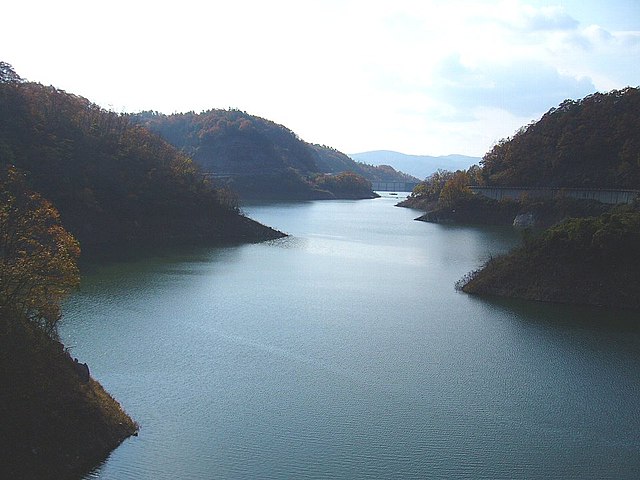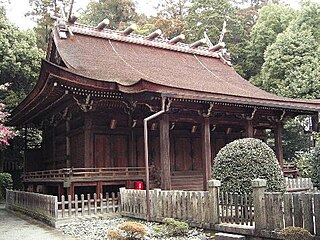Kawanishi, Hyōgo
City in Kansai, Japan From Wikipedia, the free encyclopedia
City in Kansai, Japan From Wikipedia, the free encyclopedia
Kawanishi (川西市, Kawanishi-shi) is a city located in Hyōgo Prefecture, Japan. As of 30 September 2022[update], the city had an estimated population of 155,165 and a population density of 2900 persons per km².[1] The total area of the city is 53.44 square kilometres (20.63 sq mi).
Kawanishi
川西市 | |
|---|---|
 Kawanishi City Hall | |
 Location of Kawanishi in Hyōgo Prefecture | |
 | |
| Coordinates: 34°50′N 135°25′E | |
| Country | Japan |
| Region | Kansai |
| Prefecture | Hyōgo |
| Government | |
| • Mayor | Tamio Oshio |
| Area | |
• Total | 53.44 km2 (20.63 sq mi) |
| Population (September 30, 2022) | |
• Total | 155,165 |
| • Density | 2,900/km2 (7,500/sq mi) |
| Time zone | UTC+09:00 (JST) |
| City hall address | 12-1 Chūō-chō, Kawanishi-shi, Hyōgo-ken 666-8501 |
| Website | Official website |
| Symbols | |
| Flower | Gentian |
| Tree | Sakura |



Kawanishi is located in far eastern Hyōgo Prefecture, about 5 km north of Osaka Itami Airport.[2] It is bordered on the west by the Inagawa river.
Hyōgo Prefecture
Osaka Prefecture
Kawanishi has a Humid subtropical climate (Köppen Cfa) characterized by warm summers and cool winters with light snowfall. The average annual temperature in Kawanishi is 14.0 °C. The average annual rainfall is 14759 mm with September as the wettest month. The temperatures are highest on average in January, at around 25.8 °C, and lowest in January, at around 2.6 °C.[3]
Per Japanese census data,[4] the population of Kawanishi has been increasing steadily since the 1920s.
| Year | Pop. | ±% |
|---|---|---|
| 1920 | 13,951 | — |
| 1930 | 17,039 | +22.1% |
| 1940 | 22,411 | +31.5% |
| 1950 | 32,555 | +45.3% |
| 1960 | 41,916 | +28.8% |
| 1970 | 87,127 | +107.9% |
| 1980 | 129,834 | +49.0% |
| 1990 | 141,253 | +8.8% |
| 2000 | 153,763 | +8.9% |
| 2010 | 156,476 | +1.8% |
The area of Kawanishi was part of ancient Kawabe District of Settsu Province and has been inhabited since ancient times, with the traces of a Yayoi period settlement many kofun burial mounds found within the city limits. From the Heian period, the Tada-in was a sacred site for the Seiwa Genji clan after Minamoto no Mitsunaka, a grandson of Emperor Seiwa retired to this area. From the 11th century, the Tada Silver Mine, which produced silver and copper, started. It reached peak production the 17th century, which is why this area was tenryō territory under the direct administration of the Tokugawa shogunate in the Edo period. The village of Kawanishi was established on April 1, 1889 with the creation of the modern municipalities system. It was elevated to town status on October 1, 1925. On August 1 1954 it merged with the villages of Higashitani (東谷村) and Tada (多田村) to become the city of Kawanishi.
Kawanishi has a mayor-council form of government with a directly elected mayor and a unicameral city council of 26 members. Kawanishi contributes three members to the Hyōgo Prefectural Assembly. In terms of national politics, the city is divided between the Hyōgo th district and Hyōgo 6th districts of the lower house of the Diet of Japan.
In 1884, Mitsubishi established Japan's first noted water plant in Kawanishi, this later became Mitsuya Cider.[5] At present, Kawanishi is a commuter town for workers in Kobe and Osaka, with express trains running from Osaka to Kawanishi to accommodate these travelers. Though primarily suburban, Kawanishi does have a significant agricultural sector, especially in the northern portions of the city. Major crops include peaches, chestnuts, figs, and charcoal.
Kawanishi has 16 public elementary schools and eight public middle schools operated by the city government, and four public high schools operated by the Hyōgo Prefectural Board of Education. In addition, the city also operates one special education school for the handicapped. The Toyo College of Food Technology, a junior college, is located in the city
Kawanishi is serviced by the JR Takarazuka Line and the Hankyu Takarazuka Line. Hankyu's Kawanishi-Noseguchi Station is a transfer station to the Nose Railway, which runs primarily within Kawanishi.
![]() Nose Electric Railway - Myōken Line
Nose Electric Railway - Myōken Line

Seamless Wikipedia browsing. On steroids.
Every time you click a link to Wikipedia, Wiktionary or Wikiquote in your browser's search results, it will show the modern Wikiwand interface.
Wikiwand extension is a five stars, simple, with minimum permission required to keep your browsing private, safe and transparent.